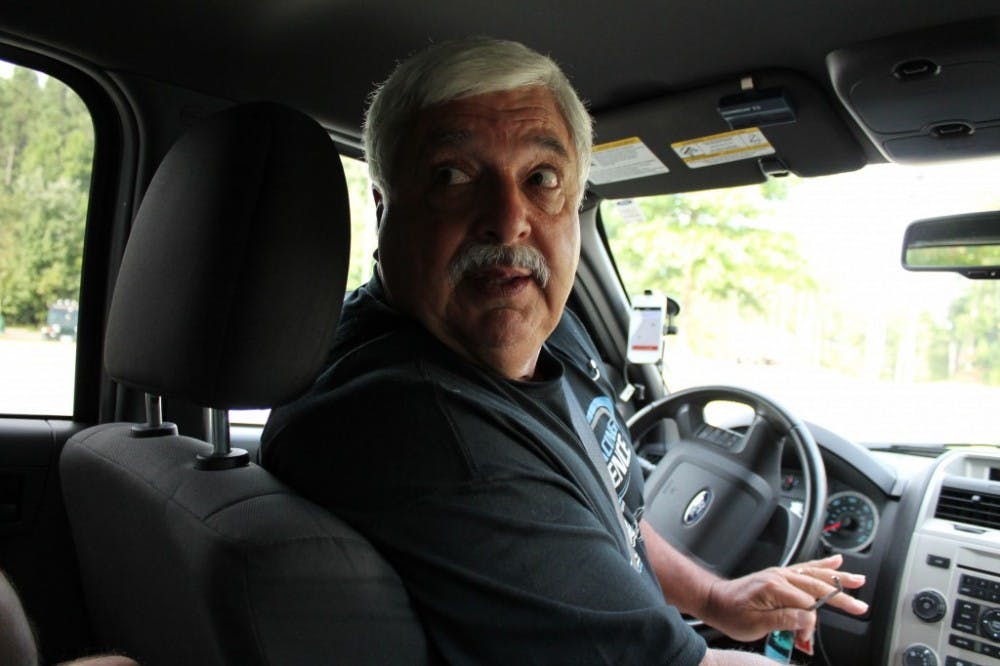Uber has arrived at Elon University.
The nationally known ride-sharing service based in San Francisco recently expanded to 25 colleges and universities across the country, recognizing the untapped potential of college students who have places to go but no transportation of their own to make it happen.
Operated through a free mobile phone application available on both iPhone and Android operating systems, Uber uses GPS technology to pinpoint the locations of drivers and their passengers. Once a ride is requested through the app, an unoccupied driver picks up the passenger. The driver’s progress can be traced in real time, through a tiny car icon that meanders through streets en-route to pickup.
The latest section of the Piedmont Triangle to experience Uber, the university and the surrounding area, could use more in the way of reliable, affordable transportation, according to Uber spokesperson Taylor Bennett. The affordability comes into play on cross-campus hops. An Uber fare from Danieley Center to West End Terrace falls between $5 and $7, even less when split between up to four people for standard Uber vehicles, as allowed by the app.
So far students have seemed to agree. New Uber driver Billy Futch has grown his steady passenger base bit by bit since becoming a driver almost a month ago. The recently retired Town of Elon resident has been filling his days driving strangers, what he called a “welcome break” from the monotony of the television-fueled days that came before.
Though he was a bit apprehensive at first, the experience has been a good one for Futch, who said his passengers have been respectful and courteous.
Because all Uber drivers are independent contractors, each sets his or her own hours and schedules, which can vary week to week. Futch logs off the app and stops giving rides by 10 p.m. during the week. Weekends sometimes go a little later, depending on traffic.
Though the Internet is rife with Uber horror stories from drivers who pick up unruly, and often intoxicated, customers who wreak havoc on the interiors of vehicles, Futch hasn’t had such problems so far.
Averaging a couple of dozen rides each week, the new Uber driver’s only complaints have been with patrons who request a ride, then cancel, causing Futch to get in his car needlessly — not that he minds, much.
“I’m sitting right here watching TV, and when the phone goes off, I go,” he said, adding that the notifications from pending riders are more a cause of excitement than of annoyance.
And his customers have not just been students. Businessmen and professors on lunch breaks and commuters bound for Raleigh via Burlington’s train station have been added to a growing list of repeat patrons, in recent weeks.
Uber’s advantages — lower fares than cabs, drivers with thorough background checks and the sort of instant-gratification the service provides — help Futch’s business expand.
“I just want the kids to be comfortable,” Futch said. “I want to hold a conversation. I want to get them there safely and get repeat customers. It’s good for me, and it’s good for them.”
Known for fares cheaper than traditional cabs, largely due to a lack of regulatory fees from state and local agencies, the ride-sharing service has taken chunks of business from them.
But cost tends to even out over longer trips, which are expensive for Uber drivers who must make the trek back after dropping off customers. Burlington-based Golden Eagle Taxi Service, whose owner could not be reached for comment, charges a flat rate of $85 for a trip from Elon University to Raleigh-Durham International Airport. Uber, by comparison, starts at $87 for the 50-odd mile trip, and ranges up to more than $100.
Extensive safety features built into the service comfort weary first-time customers, of whom Futch has had many.
Before the ride, passengers can view their driver’s photo and see specifics on the vehicle that will be picking them up. All Uber-authorized vehicles must be from 2004 or newer, be mid-to full-sized and fit an “excellent condition” descriptor, though Uber does not inspect individual cars.
Unlike the cars that pick them up, Uber passengers and drivers are rated after each trip. On a one-to-five scale, both parties are graded in terms of courtesy and respect. Uber has drawn widespread criticism for allowing passengers to see driver ratings, but blocking the same passengers from seeing drivers’ ratings of them.
Rival ride-sharing services such as Lyft, which lets passengers see their own ratings, are causing more anxiety on the part of passengers and drivers seeking to raise their “score” through fake nice behavior, Bennett said.
“We’re trying to keep this as authentic as possible. When you have those scores, then there are efforts to manipulate those scores,” Bennett said.
Elon junior Brandon Coxall-Europe, who has been one of the early Uber adapters, said he wishes the service was a little more transparent, but he doesn’t think it’ll stop students from using it. Besides, drivers aren’t going to turn down easy money, he added.
“I don’t think it’s that big of a deal,” Coxall-Europe said. “If a driver really wants to make some money, this is not New York or a huge market where they’re going to make lots. We’re in Burlingotn. If people really want to make some money, they’re going to pick you up, anyway.”
Futch, who likes to joke his new side job “keeps me out of my wife’s hair,” said the atmosphere in his car is a good one, often upbeat, always casually conversational.
But he knows he has a for-the-moment monopoly on the area, one he’s not willing to let slide without a fight.
“I really just enjoy this,” he said. “It’s not a full-time job. It’s not a way of life. But it keeps me busy, keeps me feeling a little younger. I don’t want to give that up.”


